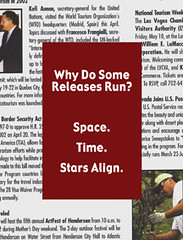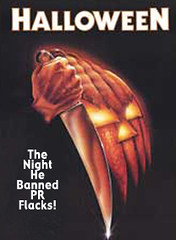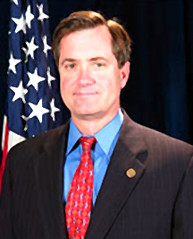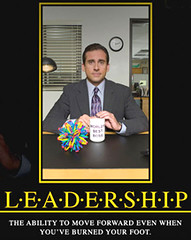Social media sometimes appears to be an inch deep and a mile wide. At least that is the way it looks to some because social media, or new media, is still in its infancy. As a result, it’s often easier to build an extension to the wafer thin model than dig deeper, proving or disproving what is being considered today.
Regardless of the sessions attended or exhibitors met at BlogWorld & New Media Expo, this point became especially apparent when Chris Brogan and Jeremiah Owyang asked their session participants if they felt they could have been a speaker — the vast majority of attendees, predominately bloggers, raised their hands without hesitation.
This isn’t a reflection on BlogWorld as much as it is an observation that many new media speakers need to deepen their topics. It’s part of the art of listening before engaging in conversation. With that in mind, I’ll highlight three sessions and save exhibitors for a deeper review another time.
Participatory Journalism
Paul Gillin, author of The New Influencers, invested ample time speaking about social media influencers (and the influencers of the influencers) and participatory journalism — which he considers the future of journalism — everyday people contributing their unique and sometimes conflicting perspectives on any given event. This media model is not all that dissimilar to the example he provided about Northwest Voice or perhaps indicative of two videos recently highlighted by Amitai Givertz, Prometeus – The Media Revolution and Epic 2015.
While Gillin is right in that traditional media is struggling to stay relevant (and funded), someone might ask if this is what we really want — a world dominated by collective opinions that make up our self-selected existence, with no one, and I mean no one, working to find the truth beyond their own biased sense of reality. It seems to me this story was already written by a gentleman named Yevgeny Zamyatin. His book, which influenced both a Brave New World and 1984, presents a dystopian society where numbers, not unlike Web addresses, replace names. The concept of transparency takes on physical form in an urban nation constructed almost entirely of glass.
Peeping Cults
And what of that world? It’s not so impossible, given the same conversation thread slipped into a Leo Laporte-led discussion on “the cult of blogging,” which featured hasty guest replacement Justine Ezarik. (Scheduled speakers were not there. Om Malik hurt his back and Mike Arrington “forgot he was speaking.”)
This is not a criticism about Ezarik. She is one of many bloggers turning to multimedia to expand their presence in a new media world. Originally a photo blogger, Ezarik presents her life as an open book and has captured an audience as a result. She’s not alone. Plenty of people are willing to live in glass houses. If that isn’t enough, check out Mogulus, which is currently in beta.
Still, most of the discussion during that session descended into developing fan bases by adding multimedia to blogs. It also touched on privacy issues, detractors, and Laporte’s justifications for not allowing comments on Twitter while not recommended other people follow suit. Interesting, but not too deep given that most of the audience was beyond focusing on passion. Not deep, because at one point, Laporte was surprised he still had a half hour to fill.
Touching Ground
That said, if there was one session that deserves props (noting that I did not attend several sessions presented by many people I read online), then it was Chris Brogan and Jeremiah Owyang who did not disappoint.
I won’t recap the presentation; Jason Falls, who I was privileged to meet and sat next to, did a fine job (skip that goofy measurement stuff though) as did Lisa Barone at Bruce Clay, Inc.. So instead, I’ll expand with a few thoughts:
1. In the rush to tell businesses that they might listen to and engage their customers, social media experts sometimes forget to listen to and engage their customers, which are those businesses.
2. Measurement begins before any social media effort is launched as that is the best place to begin benchmarking. Measurements are not necessarily tied to Alexa traffic, Technorati authority, Google page rank, etc.
3. Entering social media is more likely to succeed for businesses that employ it as an extension of their business strategy much like Owyang did for Hitachi.
4. Using a marketing megaphone makes about as much sense as standing on a street corner and waving your arms. Try adding value to the customer’s conversation.
5. Successful social media remains grounded in strategic communication. The language may have changed, but the concepts and theories are largely the same.
6. Social media tools and technologies will continue to change for a very, very long time. And that means the best reason to employ technologies like Linkedin or Facebook or mySpace is because specific customers, your customers, are there.
7. As always, it is always better to find the right people than worry about finding lots of people. This concept is already being infused into traditional marketing. Ratings and circulation are becoming less important than engaged consumers.
All in all, Brogan and Owyang succeeded in bringing the value that I was hoping to find at BlogWorld. Instead of the selling the idealistic notions about social media that will one day lead to the One State collective, they remain grounded on what needs to be done more often — offering a depth of conversation — well beyond those tempting snacks.
Social media is not always about what can be done. Sometimes it’s about why something needs to be done for each specific company. Few things just happen by following a formula. Great works need a plan.

Regardless of the sessions attended or exhibitors met at BlogWorld & New Media Expo, this point became especially apparent when Chris Brogan and Jeremiah Owyang asked their session participants if they felt they could have been a speaker — the vast majority of attendees, predominately bloggers, raised their hands without hesitation.
This isn’t a reflection on BlogWorld as much as it is an observation that many new media speakers need to deepen their topics. It’s part of the art of listening before engaging in conversation. With that in mind, I’ll highlight three sessions and save exhibitors for a deeper review another time.
Participatory Journalism
Paul Gillin, author of The New Influencers, invested ample time speaking about social media influencers (and the influencers of the influencers) and participatory journalism — which he considers the future of journalism — everyday people contributing their unique and sometimes conflicting perspectives on any given event. This media model is not all that dissimilar to the example he provided about Northwest Voice or perhaps indicative of two videos recently highlighted by Amitai Givertz, Prometeus – The Media Revolution and Epic 2015.
While Gillin is right in that traditional media is struggling to stay relevant (and funded), someone might ask if this is what we really want — a world dominated by collective opinions that make up our self-selected existence, with no one, and I mean no one, working to find the truth beyond their own biased sense of reality. It seems to me this story was already written by a gentleman named Yevgeny Zamyatin. His book, which influenced both a Brave New World and 1984, presents a dystopian society where numbers, not unlike Web addresses, replace names. The concept of transparency takes on physical form in an urban nation constructed almost entirely of glass.
Peeping Cults
And what of that world? It’s not so impossible, given the same conversation thread slipped into a Leo Laporte-led discussion on “the cult of blogging,” which featured hasty guest replacement Justine Ezarik. (Scheduled speakers were not there. Om Malik hurt his back and Mike Arrington “forgot he was speaking.”)
This is not a criticism about Ezarik. She is one of many bloggers turning to multimedia to expand their presence in a new media world. Originally a photo blogger, Ezarik presents her life as an open book and has captured an audience as a result. She’s not alone. Plenty of people are willing to live in glass houses. If that isn’t enough, check out Mogulus, which is currently in beta.
Still, most of the discussion during that session descended into developing fan bases by adding multimedia to blogs. It also touched on privacy issues, detractors, and Laporte’s justifications for not allowing comments on Twitter while not recommended other people follow suit. Interesting, but not too deep given that most of the audience was beyond focusing on passion. Not deep, because at one point, Laporte was surprised he still had a half hour to fill.
Touching Ground
That said, if there was one session that deserves props (noting that I did not attend several sessions presented by many people I read online), then it was Chris Brogan and Jeremiah Owyang who did not disappoint.
I won’t recap the presentation; Jason Falls, who I was privileged to meet and sat next to, did a fine job (skip that goofy measurement stuff though) as did Lisa Barone at Bruce Clay, Inc.. So instead, I’ll expand with a few thoughts:
1. In the rush to tell businesses that they might listen to and engage their customers, social media experts sometimes forget to listen to and engage their customers, which are those businesses.
2. Measurement begins before any social media effort is launched as that is the best place to begin benchmarking. Measurements are not necessarily tied to Alexa traffic, Technorati authority, Google page rank, etc.
3. Entering social media is more likely to succeed for businesses that employ it as an extension of their business strategy much like Owyang did for Hitachi.
4. Using a marketing megaphone makes about as much sense as standing on a street corner and waving your arms. Try adding value to the customer’s conversation.
5. Successful social media remains grounded in strategic communication. The language may have changed, but the concepts and theories are largely the same.
6. Social media tools and technologies will continue to change for a very, very long time. And that means the best reason to employ technologies like Linkedin or Facebook or mySpace is because specific customers, your customers, are there.
7. As always, it is always better to find the right people than worry about finding lots of people. This concept is already being infused into traditional marketing. Ratings and circulation are becoming less important than engaged consumers.
All in all, Brogan and Owyang succeeded in bringing the value that I was hoping to find at BlogWorld. Instead of the selling the idealistic notions about social media that will one day lead to the One State collective, they remain grounded on what needs to be done more often — offering a depth of conversation — well beyond those tempting snacks.
Social media is not always about what can be done. Sometimes it’s about why something needs to be done for each specific company. Few things just happen by following a formula. Great works need a plan.


































